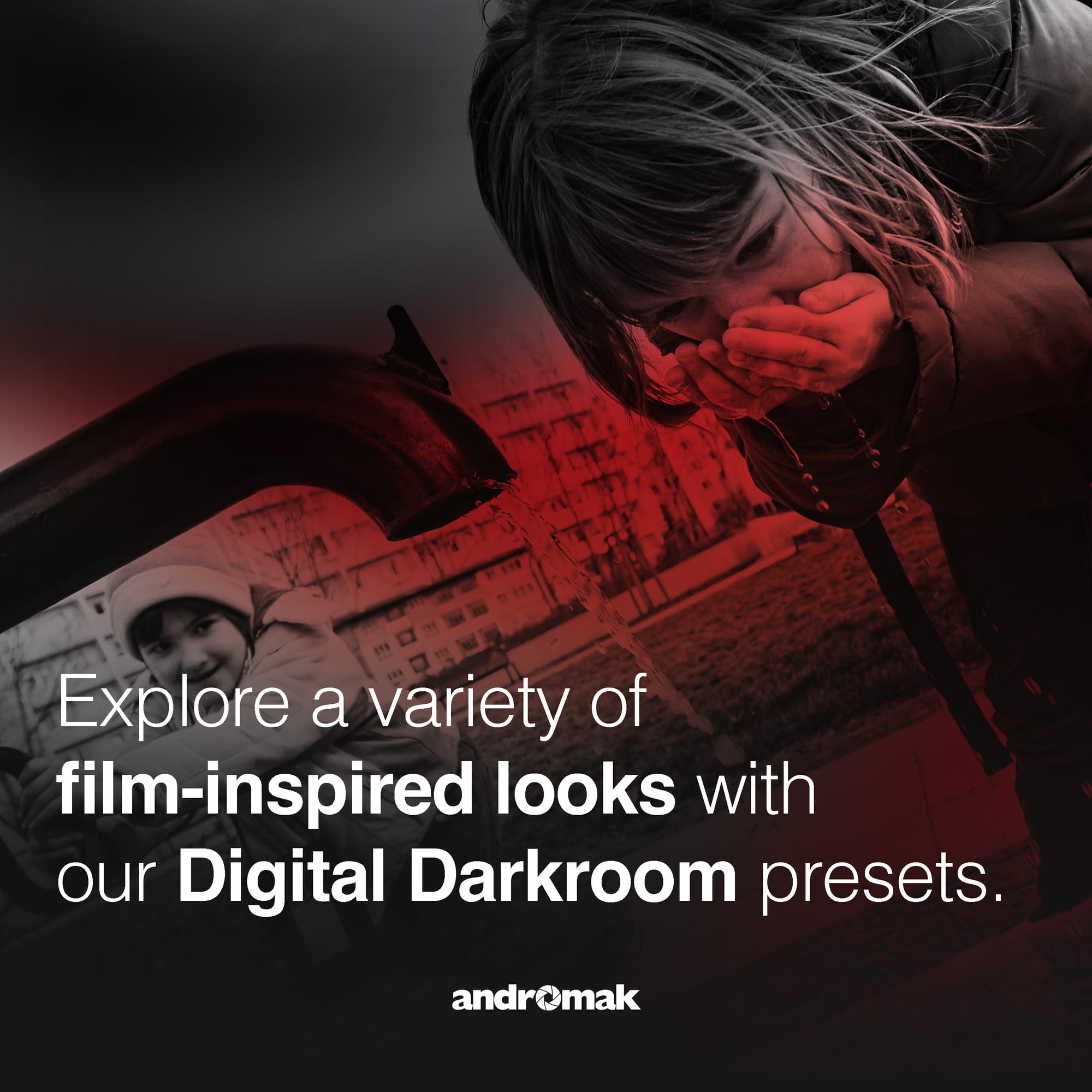In the ever-evolving world of photography, the debate between digital and film continues to captivate photographers of all levels. While film photography carries a timeless allure with its unique aesthetic, the advancements in digital technology have revolutionized the way we capture and process images. This article explores the merits of embracing a purely digital practice, highlighting the benefits it offers in terms of accessibility, flexibility, and creative potential, especially through tools like Andromak’s Digital Darkroom.

Photography, an art form that has continually evolved over the centuries, stands at a crossroads between tradition and innovation. The introduction of digital photography has transformed the medium, offering new possibilities that were previously unimaginable. As we delve into the merits of a purely digital practice, it becomes clear that digital photography provides unparalleled advantages, particularly in terms of accessibility, flexibility, and creative control. Tools like Andromak's Digital Darkroom further enhance these benefits, bridging the gap between the classic charm of film and the precision of digital technology.

The Evolution of Photography
Photography has come a long way since its inception in the early 19th century. The initial processes were labor-intensive and required a deep understanding of chemistry and physics. With the advent of film photography, capturing images became more accessible, but it still required significant effort in terms of film processing and development.
The introduction of digital cameras in the early 1990s marked a significant shift. Digital photography eliminated the need for film and introduced a new era where images could be captured, reviewed, and edited with unprecedented ease. This transformation has not only democratized photography but also expanded its creative horizons.
Advantages of Digital Photography
Digital photography offers several advantages over traditional film, making it the preferred choice for many photographers today. Here are some key benefits:
Immediate Feedback and High Storage Capacity
One of the most significant advantages of digital photography is the ability to review images immediately after they are taken. This instant feedback allows photographers to adjust settings on the spot, ensuring they capture the desired shot. Additionally, digital cameras have high storage capacities, with memory cards capable of holding thousands of images. This stands in stark contrast to film cameras, which are limited by the number of exposures per roll (typically 24 or 36 frames).
Cost-Effectiveness
While the initial investment in a high-quality digital camera can be substantial, the long-term costs are significantly lower compared to film photography. There is no need to purchase film rolls or pay for developing and printing, making digital photography a more economical choice over time.
Flexibility and Creative Control
Digital photography provides unparalleled flexibility in terms of post-processing. Photographers can edit their images using software like Adobe Photoshop and Lightroom, making adjustments to exposure, color balance, and composition. This level of control allows for creative experimentation and refinement that is difficult to achieve with film.

Digital vs. Film: Technical Comparisons
When comparing digital and film photography, several technical factors come into play:
Resolution and Image Quality
Digital cameras have made significant strides in resolution, with many models offering over 50 megapixels. This high resolution results in crisp, detailed images that can be printed at large sizes without loss of quality. Film photography, on the other hand, produces images with a distinctive grain that some photographers find aesthetically pleasing. However, film cannot match the clarity and detail of modern digital sensors.
Dynamic Range
Dynamic range refers to the range of light intensities a camera can capture, from the darkest shadows to the brightest highlights. High-quality digital cameras excel in this area, offering a broad dynamic range that allows for detailed and balanced images even in challenging lighting conditions. Film has a more limited dynamic range, which can result in lost details in high-contrast scenes.
Color Accuracy and Consistency
Digital photography provides precise control over color accuracy and consistency. Photographers can adjust white balance and color profiles to match their vision, ensuring that the final image accurately represents the scene. Film photography, while capable of producing beautiful colors, is subject to variations based on the film stock used and the development process.
The Role of Andromak’s Digital Darkroom
Andromak’s Digital Darkroom is a prime example of how digital tools can enhance the photography experience. This platform merges the best of both worlds, offering the precision of digital photography with the timeless aesthetic of classic film stocks.

Features of Andromak’s Digital Darkroom
Photo Filters: Andromak provides a variety of filters that emulate the look of traditional film stocks, such as Ilford’s black and white tones, Rollei’s rich textures, and Kodak’s vibrant colors. These filters allow photographers to achieve the desired aesthetic without the need for actual film.
Instant Editing and Feedback: With Andromak, photographers can make real-time adjustments to their images, refining them to perfection before sharing or printing.
High-Quality Output: The platform ensures that edited images maintain high resolution and detail, suitable for professional use.
Practical Considerations for Digital Photography
Digital photography is not only about the final image but also about the entire workflow. Here are some practical considerations that make digital photography advantageous:
Ease of Use in Various Conditions
Digital cameras are designed to be user-friendly, with intuitive interfaces and automatic settings that make them accessible to photographers of all skill levels. Additionally, digital cameras are less dependent on external conditions such as light and power. They can perform well in low light and challenging environments, thanks to features like high ISO capabilities and image stabilization.
Integration with Modern Technology
Digital photography seamlessly integrates with modern technology, enabling easy sharing and distribution of images. Photographers can upload their work to social media, websites, and cloud storage with just a few clicks. This integration enhances the reach and impact of their work, connecting them with a global audience.
The Creative Potential of Digital Photography
The creative potential of digital photography is virtually limitless. Here are some ways in which digital technology enhances artistic expression:
Post-Processing and Editing
Digital post-processing allows photographers to transform their images in ways that were not possible with film. From subtle adjustments to dramatic transformations, editing software provides tools to enhance the visual impact of photos. Techniques such as HDR (High Dynamic Range) imaging and focus stacking can create images with stunning detail and clarity.
Experimentation and Innovation
Digital photography encourages experimentation and innovation. Photographers can take multiple shots without worrying about the cost of film, allowing them to try new techniques and compositions. This freedom fosters creativity and leads to the discovery of new styles and approaches.
Hybrid Techniques
Some photographers combine digital and film techniques to create hybrid works. For example, they might shoot on film and then scan the negatives for digital editing. This approach leverages the strengths of both mediums, resulting in unique and compelling images.
The merits of a purely digital practice in photography are clear. Digital photography offers immediate feedback, high storage capacity, cost-effectiveness, and unparalleled creative control. Tools like Andromak’s Digital Darkroom enhance these benefits, providing photographers with the ability to achieve the timeless aesthetic of film while enjoying the precision and flexibility of digital technology.
As the photography landscape continues to evolve, embracing digital technology opens up new possibilities for artistic expression and technical excellence. Whether you are a professional photographer or an enthusiastic hobbyist, the advantages of a purely digital practice are undeniable. Explore the features of Andromak’s Digital Darkroom and experience the future of photography today.

References
- "Film vs. Digital Photography: Which Is Better?" Shotkit. [Source](https://www.shotkit.com/film-vs-digital/)
- "Comparison Of Digital And Film Photography: Exploring the Pros and Cons." Film Lifestyle. [Source](https://www.filmlifestyle.com/comparison-of-digital-and-film-photography/)
- "Digital vs. Traditional Film Photography." Lifewire. [Source](https://www.lifewire.com/digital-vs-traditional-film-photography-4929731)
By understanding and embracing the advantages of digital photography, photographers can unlock new levels of creativity and efficiency, making their artistic visions a reality with tools like Andromak's Digital Darkroom.





